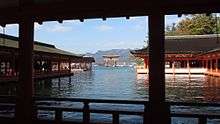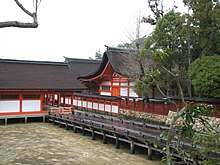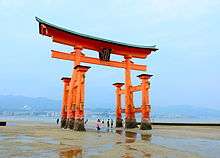Itsukushima Shrine
Itsukushima Shrine (厳島神社, Itsukushima-jinja) is a Shinto shrine on the island of Itsukushima (popularly known as Miyajima), best known for its "floating" torii gate.[1] It is in the city of Hatsukaichi in Hiroshima Prefecture in Japan. The shrine complex is listed as a UNESCO World Heritage Site, and the Japanese government has designated several buildings and possessions as National Treasures.
| UNESCO World Heritage Site | |
|---|---|
 The torii of Itsukushima Shrine, the site's most recognizable landmark, appears to float in the water | |
| Location | Itsukushima, Japan |
| Criteria | Cultural: i, ii, iv, vi |
| Reference | 776 |
| Inscription | 1996 (20th session) |
| Area | 431.2 ha |
| Buffer zone | 2,634.3 ha |
| Website | www |
| Coordinates | 34°17′45″N 132°19′11″E |
 Location of Itsukushima Shrine in Japan | |
| Itsukushima Shrine | |||||
|---|---|---|---|---|---|
"Itsukushima Shrine" in kanji | |||||
| Japanese name | |||||
| Kanji | 厳島神社 | ||||
| |||||
The Itsukushima shrine is one of Japan's most popular tourist attractions. It is most famous for its dramatic gate, or torii on the outskirts of the shrine,[2] the sacred peaks of Mount Misen, extensive forests, and its aesthetic ocean view.[1][3] The shrine complex itself consists of two main buildings: the Honsha shrine and the Sessha Marodo-jinja, as well as 17 other different buildings and structures that help to distinguish it.[3] The complex is also listed as a UNESCO World Heritage Site, and six of its buildings and possessions have been designated by the Japanese government as National Treasures.[2]
The tori gate is currently covered entirely by semi-transparent scaffolding while it is undergoing restoration works in preparation for the 2020 Olympics which is scheduled to take place in 2021.[4]
History
Origin
Itsukushima jinja was the chief Shinto shrine (ichinomiya) of Aki Province.[5]
It is said to have been erected in 593 supposedly by Saeki Kuramoto during the Suiko period.[2] However, the present shrine has been popularly attributed to Taira no Kiyomori, a prominent warlord (daimyo) who contributed heavily to the building of the shrine during his time as governor of Aki Province in 1168.[6] Another renowned patron of the shrine was the warlord Mori Motonari, lord of Choshu,[2][6] who was responsible for rebuilding the honden in 1571. It is important to note, however, that as a result of waging war against Sue Takafusa there in 1555, Motonari is said to have tainted the island's grounds by battling on the island [2] This relates to the strict notions of sacred purity that Shinto shrines stand for.[6] Unfortunately, the only surviving structure in Itsukushima shrine from the Kamakura period is the Kyakuden or "Guest-God's Shrine".
Kiyomori
It was not uncommon during the 16th century for daimyo to build shrines or take on other architectural projects in order to "reflect their power and splendor." [7] The Taira are known specifically, for their involvement in maritime trade with the Sung dynasty, and attempting to monopolize overseas trade along the Inland Sea.[8]
Kiyomori was at the height of his power when he established the Taira dominion over the island. He "ordered construction of the main hall of Itsukushima Shrine as a display of reverence for the tutelary god of navigation and to serve as a base for maritime activities..."[8] Miyajima soon became the Taira family shrine.[2] Supposedly, Kiyomori chose the location also for the reason to further establish himself in the Heian aristocracy as one who deviated from the social norms of Shinto pilgrimage .[9] He lavished great wealth upon Itsukushima, and he enjoyed showing the place to his friends and colleagues, or even to royal personages..."[10]
It is also said that Kiyomori rebuilt the shrine on account of a dream he had of an old monk who promised him dominion over Japan if he constructed a shrine on the island of Miyajima, and pay homage to its kami who are enshrined there for his success in life.[6][2] The renovations funded by the Taira allowed for Itsukushima to "grow into an important religious complex."[9]

Religious significance
The Itsukushima shrine is dedicated to the three daughters of Susano-o no Mikoto: Ichikishimahime no mikoto, Tagorihime no mikoto, and Tagitsuhime no mikoto. Otherwise known as the sanjoshin or "three female deities", these Shinto deities are the goddesses of seas and storms. Kiyomori believed the goddesses to be "manifestations of Kannon," therefore the island was understood as the home of the bodhisattva.[9] In Japanese, Itsukushima translates to mean " island dedicated to the gods" [2] In fact, the island itself is also considered to be a god, which is why the shrine was built on the outskirts of the island.[2] Adding to its sanctity, Mount Misen is "its tallest peak" ranging about "1,755 feet high."[2] Tourists can either hike or take a ropeway to the top.[2]
Its treasures include the celebrated Heike Nōkyō, or 'Sutras dedicated by the Taira House of Taira'. These consist of thirty-two scrolls, on which the Lotus, Amida, and Heart sutras have been copied by Kiyomori, his sons, and other members of the family, each completing the writing of one scroll, and " decorated with silver, gold, and mother-of-pearl by himself [Kiyomori] and other members of his clan."[2]
Originally Itsukushima was a pure Shinto shrine "where no births or deaths were allowed to cause pollution. Because the island itself has been considered sacred, commoners were not allowed to set foot on it throughout much of its history to maintain its purity. Retaining the purity of the shrine is so important that since 1878, no deaths or births have been permitted near it.[11] To this day, pregnant women are supposed to retreat to the mainland as the day of delivery approaches, as are the terminally ill or the very elderly whose passing has become imminent. Burials on the island are forbidden.To allow pilgrims to approach, the shrine was built like a pier over the water, so that it appeared to float, separate from the land.[12] The red entrance gate, or torii, was built over the water for much the same reason. Commoners had to steer their boats through the torii before approaching the shrine.

Architecture
Japan has gone to great lengths to preserve the twelfth-century-style architecture of the Shrine throughout history.
The shrine was designed and built according to the Shinden zukuri style, equipped with pier-like structures over the Matsushima bay in order to create the illusion of floating on the water, separate from island, which could be approached by the devout "like a palace on the sea."[6] This idea of intertwining architecture and nature is reflective of a popular trend during the 16th century as well as the Heian period in which Japanese structures tended to "follow after their environment," often allowing trees, water, and other forms of natural beauty to enter into the decor of homes and buildings. This led to a far more intimate relationship between the two.[7]

The most recognizable and celebrated feature of the Itsukushima shrine, is its fifty-foot tall vermilion otorii gate ("great gate"), built of decay-resistant camphor wood, .[2] The placement of an additional leg in front of and behind each main pillar identifies the torii as reflecting the style of Ryōbu Shintō (dual Shinto), a medieval school of esoteric Japanese Buddhism associated with the Shingon Sect. The torii appears to be floating only at high tide. When the tide is low, it is only approachable by foot from the island. Gathering shellfish near the gate is also popular at low tide. At night, powerful lights on the shore illuminate the torii .Although the gate has been in place since 1168, the current gate dates back only to 1875.[2]

Shinto architecture has many distinct parts, most of which include the shrine's honden ( main hall) consists of " an eight by four bay structure with a kirizuma roof"made out of cypress, and the unusually long haiden (main oratory) and its equally long heiden (offertory hall). The honden "is an eight-by-four bay structure with a kirizuma roof surfaced in cypress bark."[2] Its walls are decorated in white stucco, and the walls were constructed using a process requiring fifteen coats of white stucco, with vermilion woodwork.[2]
Extending from the sides of the haraiden of the main shrine is a noh stage which dates from 1590.[1] Noh theater performances have long been used to pay homage to the gods through the ritual acting out of key events in Shinto myth.

On September 5, 2004, the shrine was severely damaged by Typhoon Songda. The boardwalks and roof were partially destroyed, and the shrine was temporarily closed for repairs. Today anyone can go visit the shrine for only 300 yen.[2]
See also
- List of National Treasures of Japan (crafts: others)
- List of National Treasures of Japan (crafts: swords)
- List of National Treasures of Japan (paintings)
- List of National Treasures of Japan (shrines)
- List of National Treasures of Japan (writings)
- List of Shinto shrines
- List of World Heritage Sites in Japan
- Modern system of ranked Shinto shrines
- Mont Saint-Michel, a sister city and a similar island-temple UNESCO World Heritage Site
- Three Views of Japan
- Tourism in Japan
- Twenty-Two Shrines
- Three Great Shrines of Benzaiten
- Hiroshima to Honolulu Friendship Torii (Itsukushima replica)
Gallery
Photos
 A close-up of the shrine's torii
A close-up of the shrine's torii The torii at low tide
The torii at low tide The torii at sunrise
The torii at sunrise The torii at sunset
The torii at sunset The torii at night
The torii at night The torii at low tide, from the inside of the shrine.
The torii at low tide, from the inside of the shrine. The buildings that make up the shrine itself are also built in the water.
The buildings that make up the shrine itself are also built in the water. Barrels of sake in one of the shrine's "floating" buildings
Barrels of sake in one of the shrine's "floating" buildings- The shrine's halls and pathways on stilts.
.jpg) The torii gate as seen from the castle at low tide
The torii gate as seen from the castle at low tide.jpg) The torii with a visitors and view of the Seto Inland Sea.
The torii with a visitors and view of the Seto Inland Sea..jpg) Five-Tiered Pagoda at Itsukushima
Five-Tiered Pagoda at Itsukushima Deer near the torii gate
Deer near the torii gate Panorama of the floating torii gate at Itsukushima Shrine.
Panorama of the floating torii gate at Itsukushima Shrine..jpg) G7 Ministerial Meetings.
G7 Ministerial Meetings. Inside of Itsukushima main shrine (Haiden)
Inside of Itsukushima main shrine (Haiden) Bridge in Miyajima
Bridge in Miyajima- Tahōtō Pagoda
Artwork
 Aki Province: Itsukushima, Depiction of a Festival (Aki, Itsukushima, Sairei no zu from Famous Views of the Sixty-odd Provinces) by Hiroshige
Aki Province: Itsukushima, Depiction of a Festival (Aki, Itsukushima, Sairei no zu from Famous Views of the Sixty-odd Provinces) by Hiroshige.jpg) Itsukushima in Aki Province by Hiroshige
Itsukushima in Aki Province by Hiroshige Miyajima in Aki Province by Kunisada
Miyajima in Aki Province by Kunisada Aki Miyajima Shiohigari from 100 Views of the Provinces by Hiroshige II
Aki Miyajima Shiohigari from 100 Views of the Provinces by Hiroshige II Itsukushima Shrine by Kobayashi Kiyochika
Itsukushima Shrine by Kobayashi Kiyochika Mori Motonari Attacking Sue Harutaka at Itsukushima by Yoshitoshi
Mori Motonari Attacking Sue Harutaka at Itsukushima by Yoshitoshi Itsukushima moon (Itsukushima no tsuki) by Yoshitoshi
Itsukushima moon (Itsukushima no tsuki) by Yoshitoshi_by_Kawase_Hasui.jpg) Snow on a clear day at Miyajima (seiten no yuki [Miyajima]), woodblock print, from the series Souvenirs of Travel II (Tabi miyage dai nishū), by Hasui Kawase
Snow on a clear day at Miyajima (seiten no yuki [Miyajima]), woodblock print, from the series Souvenirs of Travel II (Tabi miyage dai nishū), by Hasui Kawase- Illumination of Lotus Sutra donated in 1164
.svg.png) Itsukushima Shrine Family Crest
Itsukushima Shrine Family Crest
References
- Nussbaum, Louis-Frédéric (2005). "Itsukushima-jinja" in Japan Encyclopedia, p. 407.
- Cali, Joseph; Dougill, John; Ciotti, Geoff (2013). Shinto Shrines: A Guide to the Sacred Sites of Japan's Ancient Religion. University of Hawai'i Press. ISBN 9780824837136. JSTOR j.ctt6wqfhm.
- "Ramsar and World Heritage Conventions: Converging towards success - Case study: Itsukushima Shinto Shrine, Japan" (PDF). Ramsar. 15 September 2017.
- https://www.stripes.com/not-even-restoration-work-can-detract-from-the-beauty-of-japan-s-island-of-the-gods-1.599621
- "Nationwide List of Ichinomiya," p. 3 Archived 2013-05-17 at the Wayback Machine; retrieved 2012-11-20.
- Sadler, A.L. A Short History of Japanese Architecture.
- Calza, Gian Carlo (2002). Japan Style. Phaidon. p. 190. ISBN 978-1100744452.
- Shively, Donald H. (1999). The Cambridge History of Japan, Volume 2: Heian Japan. Cambridge University Press. p. 635.
- BLAIR, HEATHER (2013). "Rites and Rule: Kiyomori at Itsukushima and Fukuhara". Harvard Journal of Asiatic Studies. 73 (1): 1–42. ISSN 0073-0548. JSTOR 44478243.
- Sansom, George (1958). A History of Japan to 1334. Stanford University Press. p. 276. ISBN 978-0804705233.
- "Itsukushima". GoJapanGo. 2010. Archived from the original on 9 June 2012. Retrieved 17 March 2011.
- Turner, Victor W. (1969). The Ritual Process: Structure and Anti-structure. Chicago: Aldine Pub.
External links
| Wikimedia Commons has media related to Itsukushima Shrine. |
- UNESCO World Heritage description
- http://www.en.itsukushimajinja.jp/index.html (in English)
- Miyajima Guide including Itsukushima Shrine
- National Archives of Japan: Itsukushima kakei